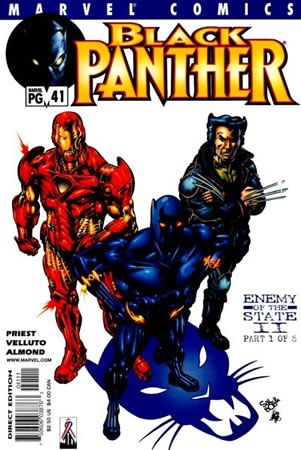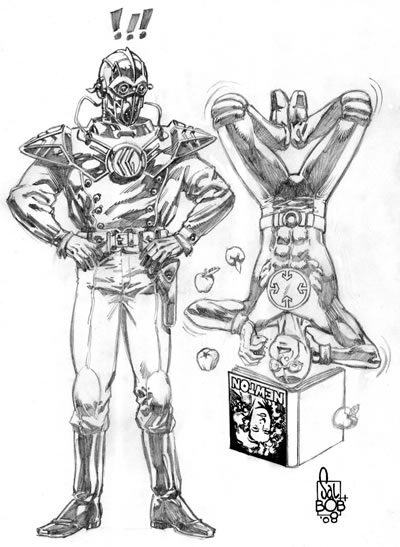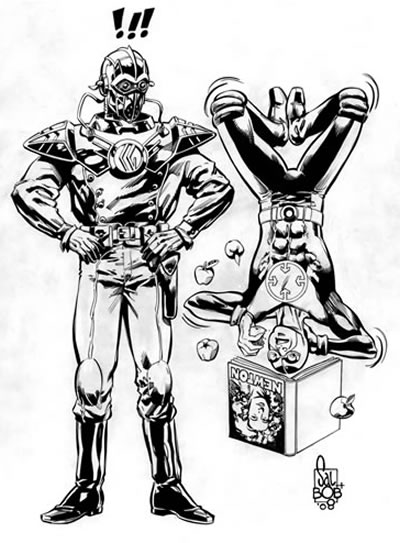There is no Gravity... the Earth sucks
Over at Comics Should Be Good — perhaps the most consistently interesting and engaging comics-focused blog on these here Internets — contributor Brian Cronin is currently taking a fan poll of favorite comic series runs.
For the benefit of the non-geeks in our audience, the term "run" describes a period of consecutive — or nearly consecutive — issues by a comics creator (writer or artist) on a specific continuing series. In the case of series with many years (or even several decades) of history, fans often speak of the evolution of a series in terms of the runs by various creators — when discussing the Amazing Spider-Man of the 1960s, for example, the Stan Lee/Steve Ditko run precedes the Lee/John Romita Sr. run.
I'm still puzzling over my top ten runs of all time, but I can guarantee that this one will make the list: the three-year run of Black Panther (December 1999 through November 2002) that featured writer Christopher J. Priest and the artistic tandem of penciler Sal Velluto and inker Bob Almond.

Priest had been writing the Panther's adventures for a year before Sal & Bob came on board (Mark Texiera, Joe Jusko, and Mark D. "Doc" Bright each drew a few issues during that period), and he continued on the book for another year after Sal & Bob departed (with art by Jorge Lucas, Jim Calafiore, and Patrick Zircher, among others). But the unique synergy occasioned by the combination of Priest's thought-provoking scripts and Sal & Bob's propulsive art lifted Black Panther to heights it had rarely achieved before (mostly during the run of writer Don McGregor in the 1970s), and never since. (I'm on the record as ambivalent about the current Black Panther series, written for the past three years by Reginald Hudlin. I appreciate Hudlin's passion for the title character and his milieu, but Reggie's characterizations — and especially his dialogue — drive me to distraction more often than not.)
Sal Velluto and Bob Almond compliment one another like smoked salmon and cream cheese. It's a sad commentary on the state of the industry when an artistic team with their ability and professionalism can't find an ongoing series on which to share their talents with the comics-buying public. Sal & Bob did, however, reunite a couple of years ago (in partnership with writer Joshua Dysart) for a delightful six-issue miniseries for Penny-Farthing Press, entitled Captain Gravity and the Power of the Vril. A fun, action-packed, nostalgic tale in the spirit of the late, great Dave Stevens's Rocketeer, it's worth seeking out.
Recently, I got Sal & Bob back together for a pair of Common Elements commissions. The first of these artworks — we'll look at the second one next Friday — teams Captain Gravity with Marvel Comics' youthful hero with similar powers, who's known simply as Gravity.
Let's look first at the raw pencil art, cleverly designed and impeccably rendered by Sal Velluto:

And now the finished version, inked by Bob Almond:

I enjoyed reading the adventures of both of these characters, short-lived though they were. They're excellent examples of the kind of stories I wish more comics companies took to the time to tell.
Captain Gravity (who has appeared in two limited-run series, the first of which was written and illustrated by a different creative team) offers an interesting spin on social issues, in that the public in Captain Gravity's pre-WWII Hollywood does not know that the man behind the hero's mask is African-American. Although it's ostensibly a superhero yarn, Captain Gravity's period setting gives it a pulp magazine appeal that I, at least, found irresistible. Both Captain Gravity miniseries are worth searching out in trade paperback format.
Gravity, who starred in an eponymous five-issue mini from Marvel Comics, reminds me of the charm and energy of early-period Spider-Man, as well the modern-age superhero Invincible (whom Gravity resembles in both costume and character). Gravity was killed off by writer Dwayne McDuffie during the subsequent miniseries Beyond!, then resurrected by McDuffie during his brief tenure on Fantastic Four. When last seen, Gravity and a coterie of his fellow C-level heroes — dubbing themselves "The League of Losers" — had embarked on a new life in a far-distant alternate future timeline.
Back with another Sal & Bob Common Elements creation next week.
And that's your Comic Art Friday.
For the benefit of the non-geeks in our audience, the term "run" describes a period of consecutive — or nearly consecutive — issues by a comics creator (writer or artist) on a specific continuing series. In the case of series with many years (or even several decades) of history, fans often speak of the evolution of a series in terms of the runs by various creators — when discussing the Amazing Spider-Man of the 1960s, for example, the Stan Lee/Steve Ditko run precedes the Lee/John Romita Sr. run.
I'm still puzzling over my top ten runs of all time, but I can guarantee that this one will make the list: the three-year run of Black Panther (December 1999 through November 2002) that featured writer Christopher J. Priest and the artistic tandem of penciler Sal Velluto and inker Bob Almond.

Priest had been writing the Panther's adventures for a year before Sal & Bob came on board (Mark Texiera, Joe Jusko, and Mark D. "Doc" Bright each drew a few issues during that period), and he continued on the book for another year after Sal & Bob departed (with art by Jorge Lucas, Jim Calafiore, and Patrick Zircher, among others). But the unique synergy occasioned by the combination of Priest's thought-provoking scripts and Sal & Bob's propulsive art lifted Black Panther to heights it had rarely achieved before (mostly during the run of writer Don McGregor in the 1970s), and never since. (I'm on the record as ambivalent about the current Black Panther series, written for the past three years by Reginald Hudlin. I appreciate Hudlin's passion for the title character and his milieu, but Reggie's characterizations — and especially his dialogue — drive me to distraction more often than not.)
Sal Velluto and Bob Almond compliment one another like smoked salmon and cream cheese. It's a sad commentary on the state of the industry when an artistic team with their ability and professionalism can't find an ongoing series on which to share their talents with the comics-buying public. Sal & Bob did, however, reunite a couple of years ago (in partnership with writer Joshua Dysart) for a delightful six-issue miniseries for Penny-Farthing Press, entitled Captain Gravity and the Power of the Vril. A fun, action-packed, nostalgic tale in the spirit of the late, great Dave Stevens's Rocketeer, it's worth seeking out.
Recently, I got Sal & Bob back together for a pair of Common Elements commissions. The first of these artworks — we'll look at the second one next Friday — teams Captain Gravity with Marvel Comics' youthful hero with similar powers, who's known simply as Gravity.
Let's look first at the raw pencil art, cleverly designed and impeccably rendered by Sal Velluto:

And now the finished version, inked by Bob Almond:

I enjoyed reading the adventures of both of these characters, short-lived though they were. They're excellent examples of the kind of stories I wish more comics companies took to the time to tell.
Captain Gravity (who has appeared in two limited-run series, the first of which was written and illustrated by a different creative team) offers an interesting spin on social issues, in that the public in Captain Gravity's pre-WWII Hollywood does not know that the man behind the hero's mask is African-American. Although it's ostensibly a superhero yarn, Captain Gravity's period setting gives it a pulp magazine appeal that I, at least, found irresistible. Both Captain Gravity miniseries are worth searching out in trade paperback format.
Gravity, who starred in an eponymous five-issue mini from Marvel Comics, reminds me of the charm and energy of early-period Spider-Man, as well the modern-age superhero Invincible (whom Gravity resembles in both costume and character). Gravity was killed off by writer Dwayne McDuffie during the subsequent miniseries Beyond!, then resurrected by McDuffie during his brief tenure on Fantastic Four. When last seen, Gravity and a coterie of his fellow C-level heroes — dubbing themselves "The League of Losers" — had embarked on a new life in a far-distant alternate future timeline.
Back with another Sal & Bob Common Elements creation next week.
And that's your Comic Art Friday.
Labels: Comic Art Friday









6 insisted on sticking two cents in:
Wow, I didn't realize that March was Bob Almond month in Swanshadow's world;-)
I want to point out another distinction from that BP run that we're sincerely proud of....to date, we hold the record as being the longest-running team on the title character, both with the writer and just the art team (Reggie is now 2nd place for writer run with Don after him and for art Kirby and Billy Graham and JRJr. following us (missing anyone from present run?) with almost no inkers staying very long except maybe McLoed and Janson before him).
Incidentally, for anyone seeking out the 2 Captain Gravity series be aware that there was also a one-shot issue between them done by the first creative team. And I didn't know that Gravity was resurrected by Dwayne. Thanks for the info!
Best,
Bob Almond
Bob: In my world, every month is Bob Almond Month. :)
Thanks for the follow-up info. I didn't realize that Hudlin had surpassed McGregor in BP issues written. I just wish I liked his stuff more than I do.
I didn't think anyone could "feel" T'Challa better than McGregor until I started reading Priest's run. Now I fear that the Panther will never get as good a writer as either of them again.
Just finished reading yet another enjoyable and informative Comic Art Friday. Also read the comments, and I didn't know that Sal and Bob hold the title to the longest artistic run on the Panther. Very interesting, and well-deserved too.
You and I may have talked about this before, but I've always had mixed emotions regarding McGregor's run on the Panther. Overall, I give it a thumbs up. But it really bothered me the way it seemed like he went out of his way to inflict as much punishment on the Panther as possible. After awhile, it became gratuitous. I can't think of another superhero in comics that ended EVERY issue beaten, battered, and bloody like T'Challa always seemed to be.
I also didn't like the fact that the Panther seemed to be cut off from the rest of the Marvel Universe. To my recollection, no other Marvel hero made even so much as a cameo during McGregor's run. I don't even think they were mentioned. It was like the Panther was in his own world, and not a major player in the MU like he eventually became under Priest's run. On the plus side, I really liked Billy Graham's art though. And I thought McGregor came up with some great villains, who, with a little polishing, could be used today.
Anyway, that's my two cents.
Damon: As always, my friend, your perspective is well-considered. My own, I know, is clouded by the dim fog of memory. If I went back and read McGregor's run today, I might have a different take on it. All the more reason why Marvel needs to get off the dime and give us an Essential Black Panther volume that collects those stories, so I can reread them without costing myself a fortune. :)
I always thought McGregor's purpose in allowing T'Challa to suffer -- and I confess that I don't recall it as sharply as you do -- was twofold: (1) it gave the character humanity (in contrast, say, to the bulletproof Luke Cage); and (2) it was kind of a '70s thing to do. Remember how Clint Eastwood's Dirty Harry got beat up in every movie, or Jim Rockford took a pasting every week on The Rockford Files? Like I said, it might read differently to me today, 30-plus years later. But at the time, that was how I viewed it.
As for the seeming isolation you mention, I thought, again, that was part of McGregor's purpose -- to portray T'Challa as the master of his realm, in his own environment, as the King of Wakanda. In his own world, as you said. The title of the book then was, after all, Jungle Action (as much as that chafes now -- though the title preceded T'Challa's becoming the featured character in the book), not NYC Action or Avengers Action or even Superhero Action. For me, part of the character's appeal was the fact that he was kind of a lone wolf (or panther), was self-sufficient and self-determining, and didn't have to rely on his fellow superheroes. (Unlike most other Marvel books of the period, where everyone bumped into another Marvel hero in practically every issue.)
Again, just my perspective. One of these days, I'd love to get McGregor and Priest -- and what the heck, Hudlin too -- on a panel at a con, just to talk Black Panther. You and I might be the only two people in the audience, but it sure would be a great hour.
You know, my take on it back then, as well as now, was that it made it seem like every hero in the Marvel Universe could get into a scrape and emerge relatively unscathed, while the Panther couldn't go up against even a D-list villain without looking like he needed a trip to the emergency room in the end. Now, while I wouldn't mind it occasionally, particularly if he went up against a particularly tough villain like Killmonger, but I thought it just seemed to be cliche when it kept happening every issue. To me, it's like when Superman goes up against Doomsday, and when the fight is over, he's all bruised, battered and bloody. It makes sense, because Doomsday is an extremely powerful foe. But what if Superman looked that way after every fight, even if were up against the Toyman, or Mr. Mxyzptlk, or the Prankster? I think after awhile fans would come away thinking "Is there anyone who CAN'T kick Superman's rear end?" That's what I started thinking about the Panther.
I remember years after Jungle Action had ended, and a McGregor Panther story arc appeared in MARVEL COMICS PRESENTS. There was the Panther on the cover, with a flaming tire around his torso and a pained look of agony on his face (actually his mask). I remember thinking: Here we go again. McGregor later wrote a Panther limited series entitled "Panther's Prey." One of the scenes I remember vividly was the villain, Soloman Prey, digging his claws into the Panther's scalp and ripping it to the bone. I decided to pass on buying that one.
You may be right about McGregor's purpose. At the time, it just seemed to me that the Panther was being segregated from the rest of the Marvel Universe. I didn't like it when Kirby did the same thing during his run on the title. I figure, what's the purpose of being in a shared universe when the character never, uh, shares?
Just fyi, Penny-Farthing Press has both runs of Captain Gravity dirt cheap, like 70 cents an issue, from their store (and the graphic novels too). Just thought to let ya'll know.
Post a Comment
<< Home